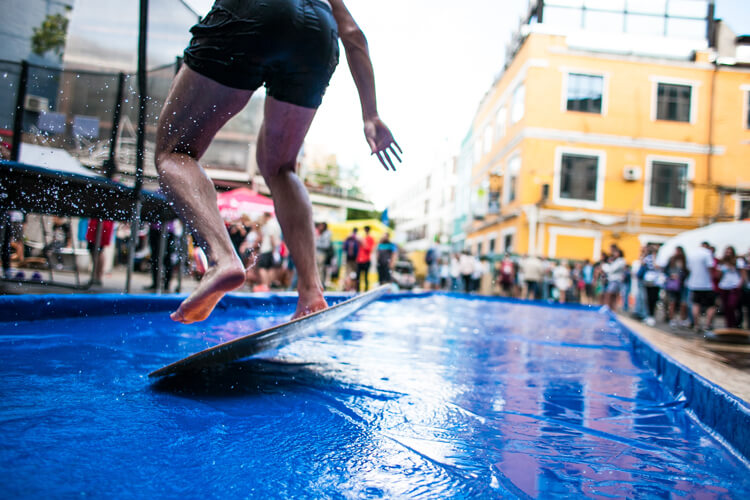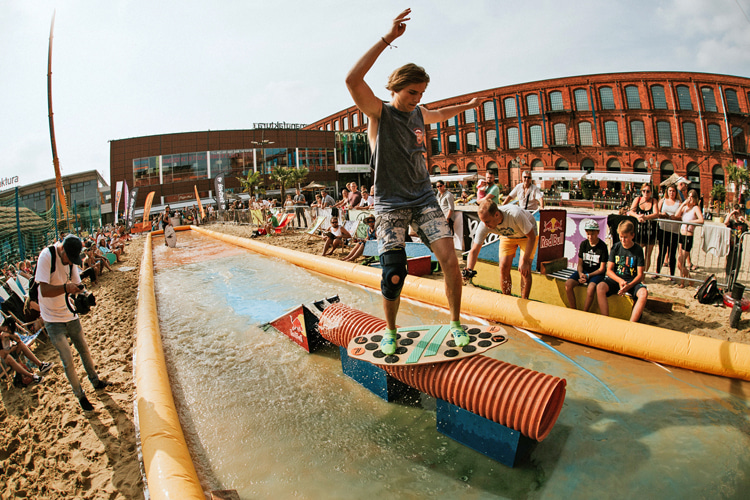Skimboarding has been around for a long time. It all started in the 1920s when beach lifeguards used long, flat wooden boards to ride the shoreline.
In the 1960s, skimboards made another comeback, with riders using completely round planks.
The sport has evolved yet again, but this time, people are noticing.
Today, skimming is very technical, and boards are very advanced with many different styles and materials.
There's the traditional wooden skimboard - the "woody" - for flatland skimming, and the carbon fiber or fiberglass board - often called a "foamie" - for waves.
Two very different skimboarding styles or disciplines have emerged.
One of them is called flatland (or inland) skimboarding, which is practiced along the shoreline with smooth, very low-level water.
Flatland skimming is more like skateboarding and incorporates various rail tricks.
The other discipline is called wave skimming, where the skimmer runs at an angle directly into the waves and rides it out, much like surfing.
Both styles are accessible to beginner and advanced skimmers and are equally fun. Where you live, and the skim spots available play major roles in the discipline you embrace.

Skim Everywhere
Flatland skimboarding, also known as inland skimboarding, is probably the easiest way to learn how to skimboard.
Nevertheless, it also offers fantastic opportunities for advanced skimboarding tricks using various ramps, rails, and other obstacles.
Flatland skimming is probably the most versatile form of skimboarding, as there are many different ways to enjoy it.
It is often performed on sandy beaches along coastal shores but can also be seen in puddles, rivers, channels, quarries, etc.
However, the most basic way to get into flatland skimming is along the water's edge. The shoreline at low tide could be an option.
Pools and channels of water at beaches, rivers, and quarries offer another level of advancement.
Pools of water are great places to set up obstacles for sliding on, such as rails, but almost anything will do - PVC piping, smooth logs, rocks for jumping over, or even old boats turned upside down.
Channels are excellent for practicing control of the skimboard.
These are obvious places to skim, but there are lots of other locations, too.
Wet grassy fields, icy, snowy, or slushy areas, fountains, and even a slick road will suffice, even though it is probably best to use an old crappy board for these rough conditions.
If it's slippery and smooth, it's probably skimmable.
Once you get the skim addiction in your veins, you will get skim goggles and see opportunities everywhere.
Skimboards and Grip
Wooden skimboards are the most common (and so far still the best) type of boards for flatland skimboarding.
They are usually shorter and rounder than wave skimboards and much thinner and heavier.
Also, wooden skimboards tend to have more rocker throughout the board with a bit of kick at the ends for tricks - like a skateboard - and they handle rails and other obstacles very well.
Wave boards have most of the rocker in the nose with a bit in the tail.
All skimboards are super smooth and slick on the surfaces, especially on the side for sliding in the water.
The deck, however, needs to have a good grip, or you will slip and slide everywhere else but on the board.
If you do manage to stay on, you won't have any control whatsoever.
Riders have three options and two materials to overcome the grip issue: they can use skimboard wax, foam-like traction pads, or a mix of both.
There is no right or wrong - just whatever you like best.
More and more skimmers and manufacturers lean towards traction pads as they are easier to use, soft on the feet, and don't get all over everything or melt in the sun.
Still, some riders prefer skimboard wax as it's heavier and gives a superior grip over the pads.
Both flatland skimboarding and wave skimboarding are equally fun and equally technical, but they are very different breeds.
At the moment, many riders consider wave skimming to be the top dog with its roots bred in the surfer style.
But flatland skimboarding is quickly rising in popularity and skill, with incredibly advanced maneuvers that adopt more of the skateboarder style.
Words by Nicole Rigler | Skimboarder
